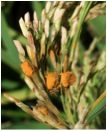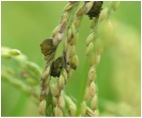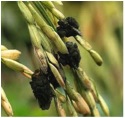Agricultural crops :: Cereals :: Rice
False smut / Lakshmi disease
Causal organism: Ustilaginoidea virens (Sexual stage: Villosiclava virens)
Symptoms:
- The fungus transforms individual ovaries/grains into greenish spore balls of velvety appearance.
- Few to several spikelets in a panicle are affected.
Pathogen:
- Sclerotia present in soil germinate and produce ascospores. They serve as primary source of inoculum.
- Chlamydospores are formed in the infected grains as spore balls which are spherical to elliptical, warty and olivaceous.
- Smut spores are air borne and responsible for secondary spread.
|
|
Initially smut balls are yellow and turn greenish black at maturity |
Favourable Conditions:
- Rainfall and cloudy weather during flowering and maturity, high soil nitrogen.
- Some of the green spore balls develop one to four sclerotia in the center.
- These sclerotia overwinter in the field and produce stalked stromata the following summer or autumn.
- In temperate regions, the fungus survives the winter by means of sclerotia as well as chlamydospores.
- The primary infections are initiated mainly by the ascospores produced from the sclerotia.
- Chlamydospores play an important role in secondary infection, which is a major part of the disease cycle.
|
Management:
Cultural methods:
- Destruction of straw and stubble from infected plants.
- Avoid field activities when the plants are wet.
- At the time of harvesting, diseased plants should be removed and destroyed so that sclerotia do not fall in the field.
- This will reduce primary inoculum for the next crop.
- Field bunds and irrigation channels should be kept clean to eliminate alternate hosts.
- Excess application of nitrogenous fertilizer should be avoided.
- Regular monitoring of disease incidence during rabi season is very essential.
Preventive methods
- Use of disease-free seeds that are selected from healthy crop.
- Split application of nitrogen is recommended.
- Removal and proper disposal of infected plant debris.
|
Chemical methods:
- Seed treatment with carbendazim 2.0g/kg of seeds.
- Spraying of Hexaconazole @ 100ml or Chlorothalonil 100ml or copper oxychloride @ 250g or Propiconazole @ 100 ml/ac at boot leaf and milky stages.
Source of information:
- AICRIP rice, TNAU, Coimbatore, Rice diseases- online resource, IRRI, Phillippines.
Acknowledgements:
|
|



